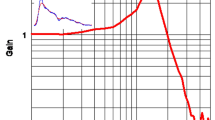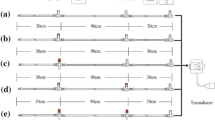Abstract
The standard method for qualitatively evaluating the dynamic response is to see if the gain of the amplitude spectrum curve approaches 1 (input signal = output signal) over the frequency band of the blood pressure waveform. In a previous report, Watanabe reported that Gardner’s natural frequency and dam** coefficient, which are widely used as evaluation methods, do not reflect the dynamic response of the circuit. Therefore, new parameters for evaluating the dynamic response of pressure monitoring circuits were desired. In this study, arterial pressure catheters with length of 30, 60, 150, and 210 cm were prepared, and a blood pressure wave calibrator, two pressure monitors with analog output and a personal computer were used to analyze blood pressure monitoring circuits. All data collection and analytical processes were performed using step response analysis program. The gain at 10 Hz was close to 1 and the systolic blood pressure difference was small in the short circuits (30 cm, 60 cm), and the gain at 10 Hz was 1.3–1.5 in the 150 cm circuit and over 1.7 in the 210 cm circuit. The difference in systolic blood pressure increased in proportion to the length of the circuit. It could also be inferred that the gain at 10 Hz should be less than 1.2 to meet a clinically acceptable blood pressure difference. In conclusion, the gain at 10 Hz is sufficiently useful as an indicator to determine the correct systolic blood pressure.




Similar content being viewed by others
References
Watanabe H, Yagi S, Namiki A. Recommendation of a clinical impulse response analysis for catheter calibration – dam** coefficient and natural frequency are incomplete parameters for clinical evaluation. J Clin Monit Comput. 2006;20(1):37–42. https://doi.org/10.1007/s10877-005-9008-6.
Gardner RM. Direct blood pressure measurement- dynamic response requirement. Anesthesiology. 1981;54(3):227–36. https://doi.org/10.1097/00000542-198103000-00010.
Schroeder B, Barbeito A, Bar-Yosef S, Mark JB. Cardiovascular monitoring, Miller’s Anesthesia, eighth edition. Edited by Miller RD. Philadelphia, Elsevier, 2015, p 1345-95.
Watanabe H, Yagi SI. Why the natural frequency and the dam** coefficient do not evaluate the dynamic response of clinically used pressure monitoring circuits correctly. J Anesth. 2020;34(6):898–903. https://doi.org/10.1007/s00540-020-02843-2.
Geddes LA. The direct and indirect measurement of blood pressure measure. Chicago. Year Book Medical Publishers; 1970. p. 48.
Frequency. response (201.12.1.101.3) of IEC 60601-2-34 (Edition 3.0 2011-05).
Acknowledgements
None.
Funding
Support was provided solely from institutional and/or departmental sources.
Author information
Authors and Affiliations
Contributions
All authors contributed to the study conception and design. Material preparation, data collection and analysis were performed by Tomoki Hirahata, Shuichi Hashimoto and Hiroaki Watanabe. Tomoki Hirahata and Hiroaki Watanabe wrote the main manuscript text and prepared Figs. 1, 2 and 3. All authors reviewed and approved the final manuscript.
Corresponding author
Ethics declarations
Clinical trial number and registry URL
None
Prior presentations
None
Summary statement
None
Competing interests
The authors declare no competing interests.
Additional information
Publisher’s Note
Springer Nature remains neutral with regard to jurisdictional claims in published maps and institutional affiliations.
Rights and permissions
Springer Nature or its licensor (e.g. a society or other partner) holds exclusive rights to this article under a publishing agreement with the author(s) or other rightsholder(s); author self-archiving of the accepted manuscript version of this article is solely governed by the terms of such publishing agreement and applicable law.
About this article
Cite this article
Hirahata, T., Hashimoto, S., Watanabe, H. et al. The 10 Hz dynamic response of a fluid-filled pressure monitoring system is a novel alternative to the fast flush test and indicative of unacceptable systolic pressure overshoot. J Clin Monit Comput 38, 715–719 (2024). https://doi.org/10.1007/s10877-023-01122-1
Received:
Accepted:
Published:
Issue Date:
DOI: https://doi.org/10.1007/s10877-023-01122-1




